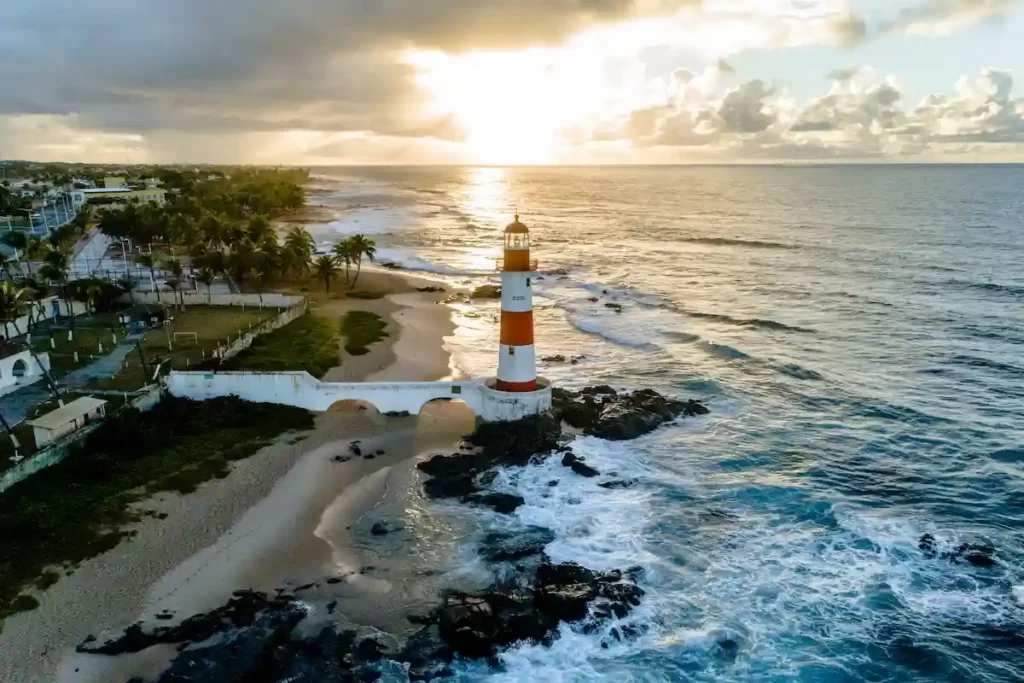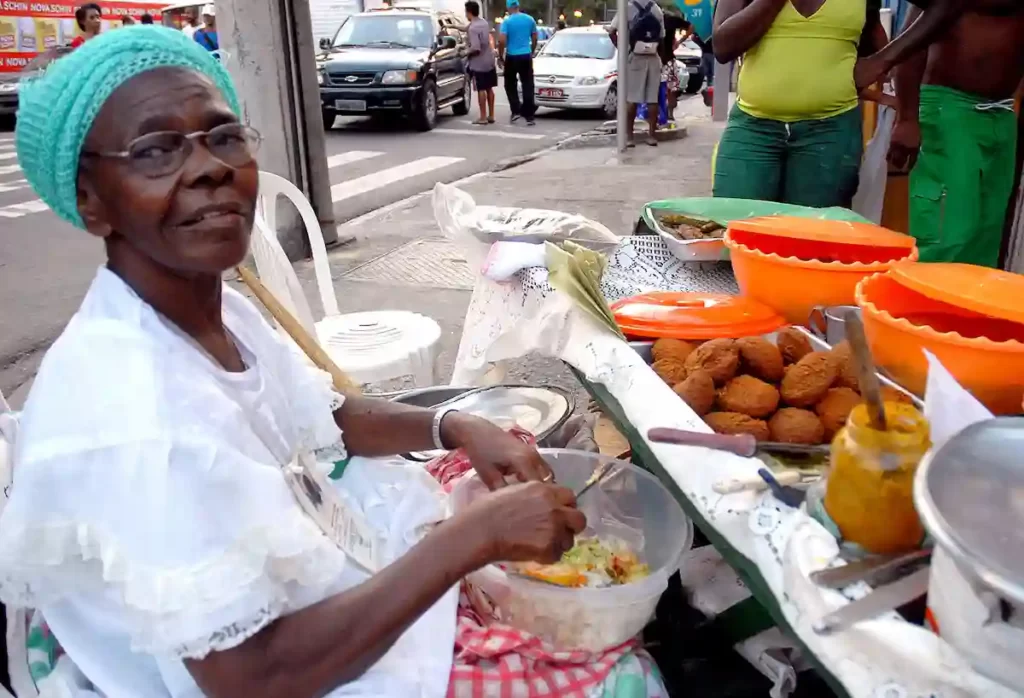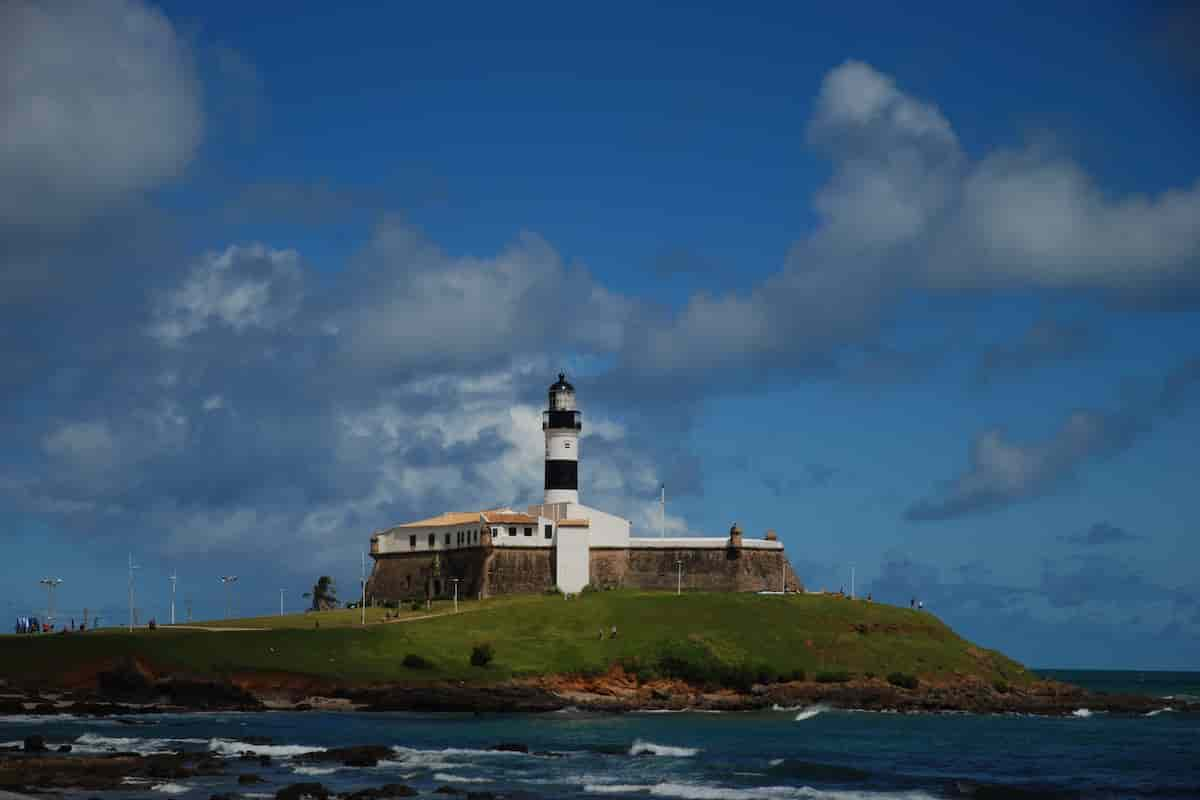Is it possible to explore Salvador – Bahia, picturesque coastal city, in just a day or a weekend? Absolutely!
We’ll walk you through the must-sees and provide invaluable travel tips for your short stay.

Salvador Bahia: The Heartbeat of Brazilian Culture
Salvador is the capital city of the state of Bahia, located in the northeastern region of Brazil. It is set on a peninsula overlooking the expansive Bay of All Saints (Baía de Todos os Santos), the largest bay in Brazil.
Founded in 1549, Salvador was Brazil’s first colonial capital. It’s a city steeped in history, with its center declared a UNESCO World Heritage Site in 1985 due to its outstanding Baroque architecture. Its cultural heritage is a blend of African, Indigenous, and European influences, making Salvador a melting pot of traditions, religions, music, and flavors.
Salvador is famed for its Carnival, which is one of the biggest and most vibrant in the world. Streets pulse with rhythm as the blocos (parade groups) move through the avenues, accompanied by Afro-Brazilian music, particularly the drum-driven Axé and Samba-reggae.
Another highlight is the Pelourinho district, often just called “Pelo”, the historic city center. It’s a maze of cobblestone alleys, pastel-colored colonial buildings, churches, and squares. Here, you can often find spontaneous music and dance performances erupting in the streets, especially the mesmerizing capoeira—a martial art that combines elements of dance, acrobatics, and music.
The amazing food of Salvador Bahia
The cuisine in Salvador is a direct reflection of its diverse heritage, with a particularly strong African influence. Here are some must-try dishes and beverages:
- Acarajé: Deep-fried balls made from black-eyed pea dough, filled with vatapá (a creamy paste made from shrimp, bread, coconut milk, and palm oil) and other ingredients like shrimp and salad.
- Moqueca Baiana: A savory seafood stew cooked slowly in a clay pot. Its ingredients include fish, shrimp, tomatoes, onions, garlic, coriander, and coconut milk, all generously drenched in dendê oil (palm oil).
- Vatapá: A delicious creamy dish made from bread, shrimp, coconut milk, finely ground nuts, and palm oil mashed into a creamy paste.
- Cocada: A sweet made from coconut, sugar, and sometimes condensed milk. It’s dense, chewy, and very satisfying.
- Quibebe: A pumpkin puree usually flavored with sugar, but sometimes made savory with spices.
- Cachaça: Brazil’s signature spirit made from fermented sugarcane juice. In Salvador, it’s commonly used to make the famous cocktail, Caipirinha.

To dine in Salvador Bahia is to embark on a gastronomic journey that tantalizes the senses with its vibrant flavors, rich textures, and aromatic spices. It’s a manifestation of the city’s deep-rooted history and diverse culture.
In conclusion, Salvador is not just a city but an experience—a lively fusion of the past and present, with its rhythms, flavors, and colors leaving an indelible mark on those who visit.
Salvador boasts awe-inspiring landmarks, making it one of the most coveted destinations in Brazil. The beaches, historical buildings, and tantalizing Bahian cuisine are all part of its unique charm.
How to Travel to Salvador, Bahia
If you’re planning to visit Salvador Bahia, here’s a comprehensive guide on how to reach this vibrant city:
1. By Air:
- Deputado Luís Eduardo Magalhães International Airport (SSA): Salvador’s main airport is one of the busiest in Brazil. It handles numerous domestic flights from major Brazilian cities like São Paulo, Rio de Janeiro, Brasília, and others. Additionally, it offers direct international flights from many cities around the world, especially from Europe and North America. Upon arriving at the airport, there are multiple ways to reach the city center:
- Taxi: You can easily find taxis outside the terminal.
- Ride-Sharing Apps: Companies like Uber operate in Salvador.
- Public Transportation: Buses link the airport to the city center, and there’s also a free shuttle to the nearest metro station.
2. By Bus to Salvador Bahia
- Salvador has a major bus terminal, Rodoviária de Salvador, which serves numerous intercity buses from all over Brazil. If you’re traveling within Brazil, this is an economical (though longer) option compared to flying.
3. By Sea:
- Salvador has a major port, and while it’s mainly used for cargo, there are some passenger services. For instance, if you’re in Morro de São Paulo, a popular beach destination, you can take a ferry or a speedboat to Salvador.
4. By Car:
- If you’re feeling adventurous, you can rent a car and drive to Salvador. Brazil has an extensive road network, and major highways connect Salvador to other parts of the country. If you choose to drive, ensure you’re familiar with local driving laws and conditions.
5. Once in Salvador:
- Public Transportation: Salvador has a metro system that connects the city center to other key locations, including the airport. Buses are also widely available.
- Car Rentals: If you prefer to explore at your own pace, there are numerous car rental agencies in Salvador where you can rent a vehicle.
- Taxis & Ride-Sharing Apps: Taxis are plentiful and can be hailed on the street. Ride-sharing apps like Uber are also popular and provide a convenient mode of transportation.
While Salvador is a beautiful and lively city, like any other major urban area, it’s essential to stay aware of your surroundings and be cautious, especially in unfamiliar or less frequented areas. Always seek local advice about the safety of neighborhoods and be mindful of your belongings.
Salvador, with its rich culture and history, is best explored with a bit of planning. While public transportation is efficient, if you want to visit off-the-beaten-path destinations or nearby coastal regions, consider renting a car.
Best Time to Visit Salvador BAHIA
Though a 3-day stay would offer a deeper dive into the city’s culture, a weekend is just enough to taste Salvador’s magic. That’s precisely how long I spent there.
Salvador is a gem in Brazil’s northeast. While it’s a year-round destination, be prepared for intermittent showers during late autumn and winter. However, these are brief spells that often freshen up the day. Summer and spring are particularly delightful, ensuring minimal rain interruptions.
Where to Stay in Salvador, Bahia
Salvador is a vibrant city with a rich history, lively culture, and beautiful beaches.
When considering where to stay in Salvador, the best neighborhood often depends on your preferences, whether you’re looking for historical significance, beachfront beauty, or vibrant nightlife. Here are some of the most popular neighborhoods for visitors:
- Pelourinho: Often referred to as the historic heart of Salvador, Pelourinho is a UNESCO World Heritage Site, brimming with colorful colonial buildings, churches, museums, and cobbled streets.
Staying here means you’re walking distance from many cultural attractions. However, be cautious at night and stick to well-lit and populated areas.
HOTEL POUSADA DA MANGUEIRA - Barra: This neighborhood offers a great blend of beach life and city amenities. It’s home to the famous Farol da Barra (Barra Lighthouse) and two popular beaches, Praia do Farol da Barra and Praia do Porto da Barra.
The area is well-lit, making it safer for evening strolls, and offers a good mix of accommodations, from luxury hotels to budget-friendly options.
THE HOTEL – BARRA - Rio Vermelho: Known for its Bohemian vibe, Rio Vermelho is a favorite among young travelers and locals. By day, you can explore the beach, and by night, the neighborhood comes alive with its vibrant nightlife, filled with bars, music venues, and the city’s best acarajé street food stalls.
HOTEL IBIS SALVADOR – RIO VERMELHO - Ondina: Located between Barra and Rio Vermelho, Ondina is a more upscale residential area with modern hotels and beachfront accommodations. It’s a bit quieter than its neighboring districts but still offers easy access to beaches and other city attractions.
- Itapuã: A bit further from the city center, Itapuã has a laid-back beach town feel. The area is famous for the Lagoa do Abaeté and its iconic Itapuã Lighthouse. It offers a mix of accommodations, with many beachfront pousadas (guesthouses).
VILA DA PRAIA HOTEL ITAPUÃ
Tips:
- Safety: Like many major cities, Salvador has areas that can be unsafe, especially after dark. Always do thorough research, stay aware of your surroundings, and take standard safety precautions.
- Transportation: Consider the proximity to transportation hubs or routes when choosing your accommodation, especially if you don’t plan on renting a vehicle.
- Activities: Think about what you want to do most (beach, history, nightlife) and choose a neighborhood that aligns with those interests.
What to explore?
- Salvador’s Beaches: Can’t-miss beaches include Itapuã, Farol da Barra, and Ondina.
- A Walk in Salvador: Start at Mercado Modelo, ascend the Lacerda Elevator, and make your way to the historic Pelourinho.
- The Mercado Modelo and Lacerda Elevator: A combo of shopping and panoramic city views for just R$0.25 (cash only).
- Pelourinho: Relish the vibrant streets and delve into the Bahian legacy. Don’t miss the iconic acarajé, a Bahian delicacy.
- Nearby Landmarks: Explore the Church of Nossa Senhora dos Rosários Pretos, Convent of São Francisco, Balé Folclórico da Bahia at Teatro Miguel Santana, and the Jorge Amado Foundation.
- Farol da Barra: A historic lighthouse with breathtaking views of the All Saints Bay.
Safety and Tips to go to Salvador Bahia
Like any major city, always be vigilant. Be wary of small scams targeting tourists, especially with ‘free’ items that aren’t genuinely free. During heavy rain, opt for indoor activities like the Jorge Amado Foundation or Teatro Miguel Santana.
This guide is a concise itinerary for those short on time in Salvador. Happy travels!


